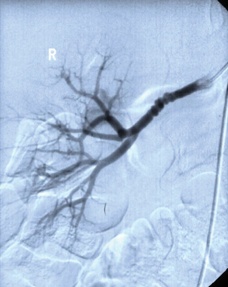MKSAP Quiz: High BP and oral contraception
A 27-year-old woman is evaluated during a follow-up visit for high blood pressure that manifested 4 months after she began taking an oral contraceptive pill. Despite stopping the oral contraceptive pill, her blood pressure has remained high. She states that she feels well. Medical history is otherwise unremarkable, and she takes no medications.
On physical examination, blood pressure measurements are 150 to 166 mm Hg systolic and 100 to 108 mm Hg diastolic without orthostasis; other vital signs are normal. There is a bruit in the right epigastric region. The remainder of the examination is unremarkable.
Kidney function is normal, and urinalysis is unremarkable.
A kidney angiogram is shown.

Which of the following is the most appropriate next step in management?
A. ACE inhibitor
B. Calcium channel blocker/ACE inhibitor combination
C. Percutaneous transluminal kidney angioplasty
D. Surgical revascularization
Answer and critique
The correct answer is C: Percutaneous transluminal kidney angioplasty. This question can be found in MKSAP 16 in the Nephrology section, item 58.
Percutaneous transluminal kidney angioplasty is indicated for this patient with renovascular hypertension secondary to fibromuscular dysplasia, a nonatherosclerotic, noninflammatory renovascular disease. Renovascular hypertension due to fibromuscular dysplasia is most commonly caused by medial fibroplasia of the renal artery. On angiogram, the characteristic finding of fibromuscular dysplasia is the “string of beads” appearance of the involved artery, which is apparent in this patient's angiogram. Fibromuscular dysplasia is a disease of unknown cause and most commonly involves the renal and carotid arteries. Hypertension caused by fibromuscular dysplasia is more common in women and usually affects patients between 15 and 30 years of age. Catheter-based kidney angiography is the most accurate method to diagnose this condition. This study is indicated for patients whose clinical presentation raises strong suspicion for fibromuscular disease related hypertension, such as those with severe resistant hypertension and high plasma renin activity. Revascularization with kidney angioplasty may be performed at the same time as diagnostic angiography. The young age of many patients with fibromuscular dysplasia, such as this 27-year-old woman, reduces the risk of complications from this procedure.
The high likelihood of both technical success and meaningful blood pressure improvement from kidney angioplasty makes drug therapy in this young patient unnecessary at this time.
Surgical revascularization is not first-line treatment for this patient given the higher morbidity. Surgery should be reserved for patients who do not respond to kidney angioplasty or who have arterial anatomy too complex for kidney angioplasty.
Key Point
- Management of renovascular hypertension secondary to fibromuscular dysplasia may involve revascularization with kidney angioplasty.




